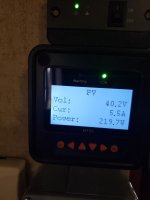Yeah my experience is the same as Stew's with new/recent panels. Maybe the 50% was referring to daily output? Your peak output is going to be full sun on a cloudless day at whatever time the sun hits those panels just right. You're not going to see that at 10am or 5pm although the panels will still have some output. Every system and situation is going to be different (especially based on location) but it wouldn't be a bad rule of thumb to take "an hour after sunrise to an hour before sunset" as your "solar day", multiply that number of hours by your panel's max rating to get watt-hours, and then knock it back 50% to get a more realistic "ideal charging day".
I think it's super helpful to pair a system with some type of monitor that has logging functionality. Stew's post above looks like the EPEver MT50, which is what I use as well (I have an EPEver Tracer-AN 40). That unit can connect to a data logger EPEver sells called the Elog01, or you can add an aftermarket system. I'm not shilling for them, but I'm a fan of the RVWhisper system with the Thermowave power module. With it, I can see what my panels are putting out and chart it over time. It can really help you understand how solar performs.
One common gotcha a lot of folks don't realize is a concept called "panel shading". Depending on how your panel is wired, even a small amount of shading like from a tree branch or power pole can knock out a significant percentage of your output. There are some good videos on Youtube that talk through this if you want more explanation.

